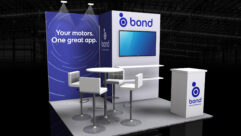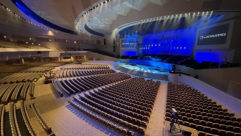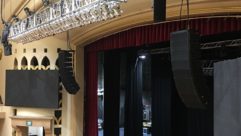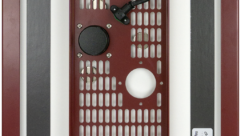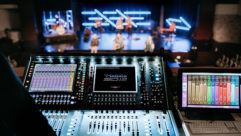Leaps and Bounds
Jun 1, 2003 12:00 PM,
Glen Ballou
Many years ago, I spent rainy Sunday afternoons in museums. My father loved history, so we would stop at every artifact and read those infernal placards word for word. I vowed that I would never subject my family to those static and boring museums.
Fortunately, times have changed. Museums have replaced those static placards with interactive displays and audiovisuals. Visitors are now accustomed to a multimedia environment that mixes entertainment with an educational message.
The original museum audio systems included narrations and sound effects. Loudspeakers would be mounted in front of the exhibit, often at knee level. The source would be continuous loop tapes, the likes of which could not be rewound. If they ran continuously, the listener would come into the dialogue at any point and have to wait before he or she could hear the beginning. If the tape was capable of stopping at the end of the narration, the listener could push the start button and hear the message from the beginning. Often multitrack playback tape machines were used so you could pick your language of choice. Although it was not the best system, it was much better than those boring placards.
Another early system, which is still used today, transmitted the signal on a loop that surrounded the audience area. The listeners wore a receiver and an earpiece, and as long as they were within the boundary created by the loop, they could hear the recording. As they stepped outside of the loop, the signal disappeared. They could then go to the next exhibit, step into its loop, and hear the dialogue.
Advantages of the system are it is simple, is reasonably reliable, and works with hearing aids. However, the system’s drawbacks include a poor frequency response, making it useful for voice only. Also, because the signal is analog and operates much like an AM radio station, the volume varies with the distance of the listener to the loop. Lastly, it requires a wire loop around the area of interest, which is sometimes difficult to install and hide.
In 1957 the visitors carried a reel-to-reel tape recorder over their shoulders. With this system, they not only heard the message but also received their exercise for the day.
Since those days, radio frequency (RF) systems have come into operation. This has made the systems much more versatile and easier to install. Many RF systems are available, some simple and others complex. The following are a few of those systems. This is only an indication of some of their capabilities; to find more about each system and the latest updates, go to the company’s Web site.
SYSTEMS CHECK
Acoustiguide has been in business for more than 40 years. Its major system is the Acoustiguide 2000 Series and includes three AG 2000 players — the Wand, the Mini, and the Maxim. All three systems use MP3 and Windows Media Audio 4.0 for full production sound and the company’s own software, called Vocoder, for voice only.
The Wand is 12.50 inches long, 2.50 inches wide, and 0.75 inches deep and weighs 9.2 ounces (Fig. 1). It can hold up to 500 selectable languages or programs or as many as 8,000 messages. The controls include play, clear, pause, fast-forward, rewind, volume up, and volume down. It can play for 12 hours continuously without charging and can accommodate surveys, games, and educational question-and-answer formats. Battery charging can be accomplished in three hours in the charging/programming rack.
Because of the design of the Wand, it is easy to encourage corporate sponsorship, including rotating logos on the LCD and logos and graphics on the flat areas of the casing.
The Mini has many of the same features as the Wand. The Mini is ideal for highly produced audio programs that blend narration, archival audio, large interviews, music, and sound effects, making exhibits come to life. The Mini comes with headsets or single earpieces. The unit is 5.60 inches long, 2.60 inches wide, and 0.75 inches deep and weighs 5 ounces. The controls are the same as with the Wand. It will also play for 12 hours without charging and can be fully recharged in 3 hours.
The Maxim can hold 200 hours of stereo sound or more than 2,000 hours of voice in linear, random access, or combination tours. It can hold 500 programs and more than 12,000 messages on each unit to provide tours on different subjects or foreign languages. The unit is 7.0 inches long, 3.9 inches wide, and 1.5 inches deep and weighs 15 ounces. It has the same controls as the Wand and the Mini.
The Acoustiguide storage racks recharge the batteries and include a programming card that is about the size of a credit card. The programs can be written either by the client or by Acoustiguide, which can provide creative and production services. The programs are downloaded from the Internet or from CDs onto a laptop computer. As new material is written, recorded, and digitized, it is put on the program card, which automatically updates the players as they are being charged.
The visitor is given a player to operate the system. A staff member sets up the player for the language and the complexity of the tour. The tour could be long or abbreviated to control traffic when the museum is crowded or can be set up for adults or children. The visitor can adjust volume at each area to compensate for noise level. When the visitor is at an exhibit, he or she punches in the number corresponding to the exhibit as shown on a placard. The visitor can then pause the program, rewind it, or fast-forward it.
WEIGHING THE OPTIONS
Another system is made by Tour-Mate. Its SC500 Listening Wand is 13.0 inches long, 1.8 inches wide, and 1.0 inch deep and weighs 8 ounces. A carrying strap is attached inside the wand for added strength so that it cannot be unclipped by the user. The system is powered by a rechargeable nickel hydride battery pack that delivers ten hours of continuous play from a full charge. It can be recharged in three to four hours.
The maximum capacity of the system is 24 hours of mono sound or 12 hours of stereo sound. The message can be expanded on-site. The wand can store several tours and versions of the tour. The software permits a staff member to type in a code that locks out all tours but the desired one. A keystroke permits one to see what version of the tour has been selected.
The Tour-Mate Editing Capability software is Windows compatible and runs on a PC platform using a Pentium processor. The editing software permits the user to input tour messages or message segments and to perform such functions as cut, paste, parametric equalization, normalization, variable gain, variable compression, insert message queues, and program message sequences.
MyGuide by Espro is a system much like the previous two. It uses a wand that has the tour narration downloaded from the storage rack/power supply recorded through a flash memory card. This system runs for ten hours between charging and can have up to four hours of audio capacity. The bandwidth is between 300 Hz and 4 kHz, so it is particularly useful for voice only.
The ExSite MP3 system by Espro can have as much as 72 hours of multilingual content, uses a wide alphanumeric and graphic LCD, and can be synchronized to external multimedia presentations such as DVD and video. It can also collect and analyze visitor usage data. The system can be used with the unit’s built-in speaker or with plug-in earphones.
Espro’s GroupGuide is a portable system for group tours in which the visitor wears a personal receiver with headphones, and the guide wears a transmitter with microphone. AKG, Sennheiser, and Williams Sound also have tour systems using wireless microphones and wireless receivers.
IR SYSTEMS
Sennheiser and other manufacturers make another type of system that uses infrared (IR) transmission. In this system, the message is transmitted through wireless infrared using amplitude and frequency modulation processes. It comes in either narrow band for multichannel setups or wide band for high quality. The area of reception is confined to line-of-sight or an individual room. Through reflections, however, it can bounce around corners into other unwanted areas. Although it can cover large areas effectively, it is limited when it comes to multiple exhibits in a confined area. Another problem with IR is its inability to compete with the sun or very bright areas.
Dual-channel systems normally operate subcarriers of 95 kHz/250 kHz or 2.3 MHz/2.8 MHz. The emitters are placed around the room to give even coverage, and they may be daisy-chained for easy installation. Probably the newest and most sophisticated system is GuidePort by Sennheiser. This system is completely different from the other systems and therefore deserves more time to discuss it.
With GuidePort the museum is set up into zones or cells (see Fig. 2). These zones may be separate rooms or floors or a section of a large room. Audio files that are associated with the exhibits in a cell and their corresponding identifier unit are created or stored on a standard PC. The files are then uploaded by GuidePort software to multichannel RF wireless cell transmitters, which are located in each individual cell. Each cell transmitter stores audio for its particular zone. This provides the audio (prerecorded or live stream) that is downloaded into the visitors’ receivers when they enter the cell or defined zone within the museum. Because the audio for all of the exhibits in each zone is stored in the visitors’ receiver while they are in that zone, the GuidePort system can handle as many visitors as a facility has receivers.
GuidePort’s charger system can store and charge ten wireless receivers. Chargers can be linked to accommodate more than 5,000 receivers. Receivers can operate for as long as eight hours between charges. The charger system is linked to the control unit (PC) to allow for programming the receivers for language or level.
To enable management of a frequently changing exhibit environment, Sennheiser engineered a list-based audio configuration software so the museum management can control the audio tours by simply updating the master audio list as exhibit items and corresponding identifiers are moved.
Discreet wireless antennas are strategically placed throughout the exhibit to allow receivers and cell transmitters to work together. The system is designed to operate on license-free dedicated radio frequencies in the 2.4 GHz ISM band that are ideal for digital audio and resistant to outside radio interference.
Battery-operated or externally powered wireless identifier units are hidden near or behind each exhibit. The wireless architecture behind the GuidePort system allows for quick and easy setup of the museum because, as an exhibit is moved, the associated identifier is moved along with it, making it easy to rearrange an exhibit space.
The visitors are given a lightweight receiver that fits comfortably in the palm of their hand or can be hung around their neck, and a headset. A staff member programs the receiver to the language or level the visitor desires. The system is handsfree, so the visitor is not required to press buttons to match exhibit placards. The visitors proceed into the exhibit at their own pace, and as they move from exhibit to exhibit, the system automatically dissolves the audio from the previous message to the new one. Visitors can adjust the volume, pause, or repeat information they would like to hear again. The headphones fit all age groups and can include a sponsor logo.
When the visitor enters a zone, audio files for all of the exhibits within that zone are downloaded into the visitor’s receiver. The identifiers automatically trigger the receiver when a visitor is within a specified range of the displayed item to play the corresponding audio file. The trigger range, along with other parameters of the identifier, can be programmed using an infrared-enabled, Palm-compatible PDA.
GuidePort can integrate live audio into the presentation. The visitor can listen to live demonstrations, concerts, movies, and video presentations with synchronized sound just by walking into the area. The visitor can walk to a new area, and the audio program will automatically change.
All stationary components of GuidePort are located in a central location. Cell transmitters interface with their Base Station PC through USB ports. A larger facility can network multiple Base Station PCs, including through an existing network. Antennas are connected using standard shielded Cat-5 cable. Audio files may be created anywhere in any standard format, which are then converted to WAV files before they are imported into the GuidePort system. The Base Station PC and central control unit are needed only when configuring or reconfiguring the system, and they could be substituted with a temporary PC or notebook.
The preceding examples are just a few of the museum systems in existence today. As you can see, museum tour systems can be a lucrative business for sound contractors.
Glen Ballou owns Innovative Communications and is the author of The Handbook for Sound Engineers — The New Audio Cyclopedia.


